Analysis of Lateral Displacement of Pile Foundation Caused by Large-Diameter Shield Tunneling
Abstract
:1. Introduction
2. Lateral Displacement of Front Pile Caused by Using a Shield Machine
2.1. Horizontal Displacement of Soil Caused by Shield Tunneling
2.2. Pile Foundation Displacement Caused by Soil Displacement
3. Numerical Simulation Verification Results
4. The Influence of Shield Construction on the Displacement of the Front Pile Foundation Discussion
5. Conclusions
- (1)
- The Mindlin elastic solution and simplified pile–soil foundation model can be used to solve the lateral displacement of the pile foundation caused by the deep-buried shield, which can accurately predict the overall lateral displacement of the pile foundation in front of the shield. MATLAB programming language can be used to realize a simple and efficient calculation, which can provide fast and accurate guidance for shield design and construction.
- (2)
- Comparing the numerical and theoretical results of the influence of the shield construction on the displacement of the front pile foundation, for the upper part of the pile foundation, the theoretical calculation is similar to the numerical one. For the lower part of the pile foundation, when the shield is closer to the pile foundation, the theoretical calculation value is larger, and the result is conservative.
- (3)
- A larger shield additional thrust and closer excavation face distance will cause larger displacement in the lower part of the pile foundation. In the design, the distance between the excavation face and the pile foundation should be larger than the pile diameter. During construction, when the distance between the excavation face and the pile foundation is small, the shield thrust should be reduced as much as possible to reduce the influence on the pile tip displacement and the pile foundation inclination.
- (4)
- Compared with changing the additional thrust of the shield and the distance from the excavation face, changing the outer diameter of the shield has only a small effect on the overall lateral displacement of the pile foundation. In order to control the deformation of the stratum, it is suggested that the distance between the tunnel and the pile foundation should be reasonably determined in the design stage, and the thrust of the shield should be reasonably controlled during the construction. Changing the outer diameter of the shield has a large influence on the displacement of the pile top. The key to controlling the displacement of the pile top and the ground surface is the outer diameter of the shield. It is suggested that the influence of the outer diameter of the shield should be considered when calculating the displacement of the pile top and the ground surface in the design stage.
Author Contributions
Funding
Institutional Review Board Statement
Informed Consent Statement
Data Availability Statement
Conflicts of Interest
References
- Mindlin, R.D. Force at a Point in the Interior of a Semi-Infinite Solid. J. Appl. Phys. 1936, 7, 195–202. [Google Scholar] [CrossRef]
- Wei, G.; Xu, R. Prediction of Longitudinal Ground Deformation Due to Tunnel Construction with Shield in Soft Soil. Chin. J. Geotech. Eng. 2005, 27, 1077–1081. [Google Scholar] [CrossRef]
- Feng, G.; Xu, X.; Hou, S.; Fan, D.; Yang, K.; Guan, L.; Xu, C. Deflections of Adjacent Underground Tunnel Induced by Excavation Based on Kerr Foundation Mode. J. Shanghai Jiaotong Univ. Sci. 2022, 56, 474–485. [Google Scholar] [CrossRef]
- Liang, R.; Xia, T.; Lin, C.; Yu, F. Analysis of Ground Surface Displacement and Horizontal Movement of Deep Soils Induced by Shield Advancing. Chin. J. Rock. Mech. Rock. Eng. 2015, 34, 583–593. [Google Scholar] [CrossRef]
- Wu, C.; Zhu, Z.; Song, S.; Zhang, J.; Peng, Y. Ground Settlement Caused by Large-Diameter Slurry Shield During Tunnel Construction in Soft Soils. Chin. J. Geotech. Eng. 2019, 41, 169–172. [Google Scholar]
- Verma, A.; Jawaid, S.M.A. Winkler’s Based Parametric Analysis of Unplugged Short Pipe Pile. Lect. Notes Archit. Civ. Eng. 2022, 154, 107–116. [Google Scholar] [CrossRef]
- Pasternak, P.L. On a New Method of Analysis of an Elastic Foundation by Means of Two-Constants; Gosudarstvennoe Izdatelstro Liberaturi po Stroitelstvui Arkhitekture: Moscow, Russia, 1954. [Google Scholar]
- Zhang, H.; Zhang, Z. Estimating the Effects of Shield Tunnelling on Buried Pipelines Based on a Kerr Foundation Model. In New Frontiers in Engineering Geology and the Environment, Proceedings of the International Symposium on Coastal Engineering Geology, ISCEG, Shanghai, China, 20–21 September 2012; Springer: Berlin/Heidelberg, Germany, 2012; pp. 263–268. [Google Scholar] [CrossRef]
- Zong, X. Study of Longitudinal Deformation of Existing Tunnel Due to Above Excavation Unloading. Rock Soil Mech. 2016, 37, 571–577+596. [Google Scholar]
- Feng, G.; Xu, C.; Zheng, M.; Xue, Q.; Yang, K.; Guan, L. Deflection of Overlying Pipeline Induced by Shield Tunneling Considering Effect of Lateral soil. J. Zhejiang Univ.—Eng. Sci. 2021, 55, 1453–1463. [Google Scholar]
- Feng, G.; Xu, C.; Zheng, M.; Xue, W.; Yang, K.; Guan, L. Study of Longitudinal Deformation of Existing Underlying Tunnel Due to Above Excavation Considering Shear Deformation of Tunnel. J. Chin. Railw. Soc. 2022, 44, 132–141. [Google Scholar] [CrossRef]
- Huang, Q.; Huang, H.; Zhang, D. Steady-State Response of an Infinite Euler-Bernoulli Beam on Kerr Foundation Subjected to a Moving Oscillating Load. J. Vib. Shock. 2018, 37, 14–20. [Google Scholar] [CrossRef]
- Zhang, Z.; Zhang, C.; Jiang, K.; Wang, Z.; Jiang, Y.; Zhao, Q.; Lu, M. Analytical Prediction for Tunnel-Soil-Pile Interaction Mechanics based on Kerr Foundation Model. KSCE J. Civ. Eng. 2019, 23, 2756–2771. [Google Scholar] [CrossRef]
- Zhou, X.; Yang, J.; Liu, T. Analysis on the Influence of Shield Construction on Lateral and Closely Cross Bridge Pile Foundation. Chin. J. Undergr. Space Eng. 2022, 18, 586–595. [Google Scholar]
- Gan, P.; Shan, Z.; Liu, S.; Wang, Q.; Mao, Q. Numerical Analysis on Mechanical Behavior of Pile Group Due to Tunnelling. Chin. J. Undergr. Space Eng. 2019, 15, 657–665. [Google Scholar]
- Potyondy, J.G. Skin Friction between Various Soils and Construction Materials. Géotechnique 1961, 11, 339–353. [Google Scholar] [CrossRef]
- Feng, G.; Dou, B.; Zhang, G.; Ding, S.; Xu, C. Simplified Calculation Method for Lateral Displacement of Passive Pile Caused by Tunneling. J. Civ. Environ. Eng. 2021, 43, 10–18. [Google Scholar] [CrossRef]
- Li, M.; Chen, G.; Fan, X.; Xu, P.; Ding, S.; Sun, Z.; Xu, C. Numerical Study and Parametric Analysis of Influence of Tunnel Excavation on Adjacent Pile Foundation. J. Civ. Eng. Environ. Sci. 2022, 44, 45–52. [Google Scholar] [CrossRef]

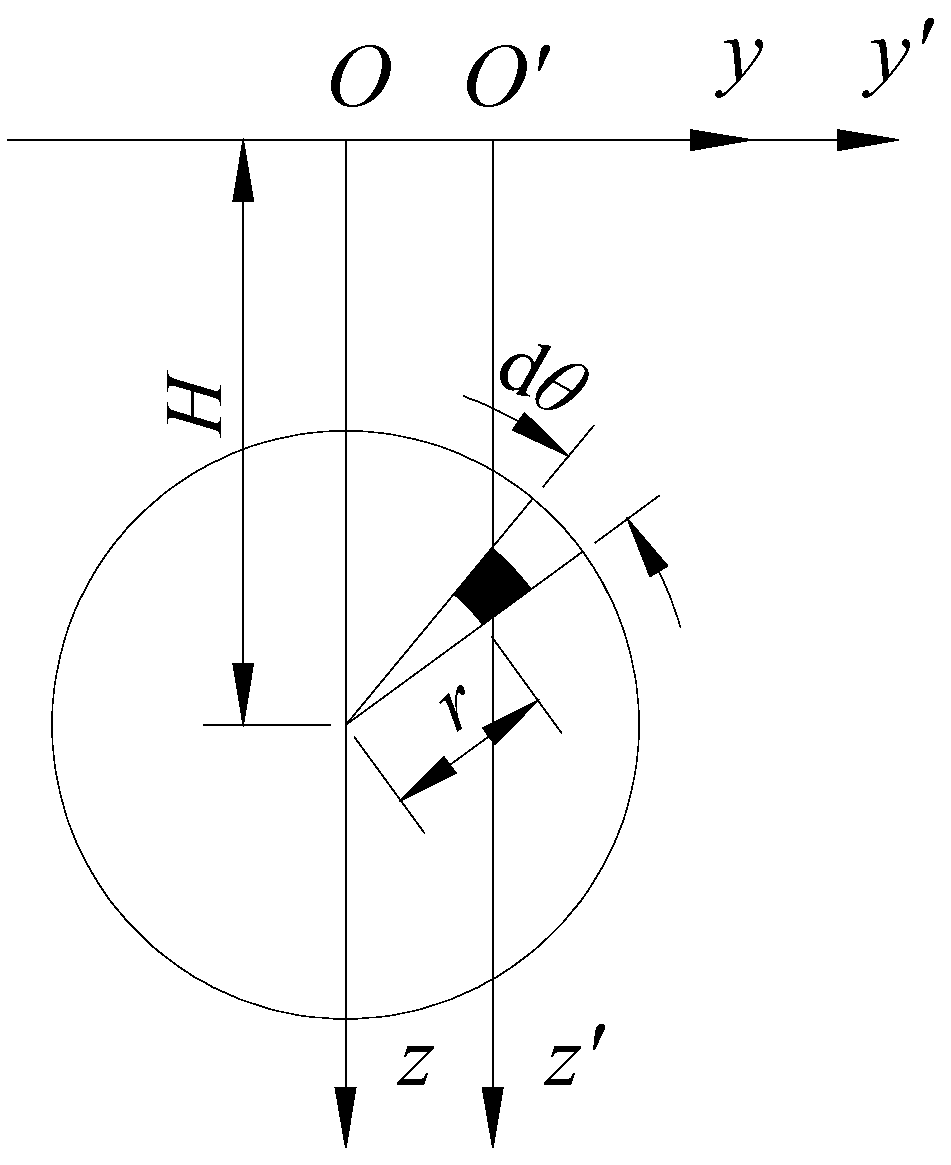
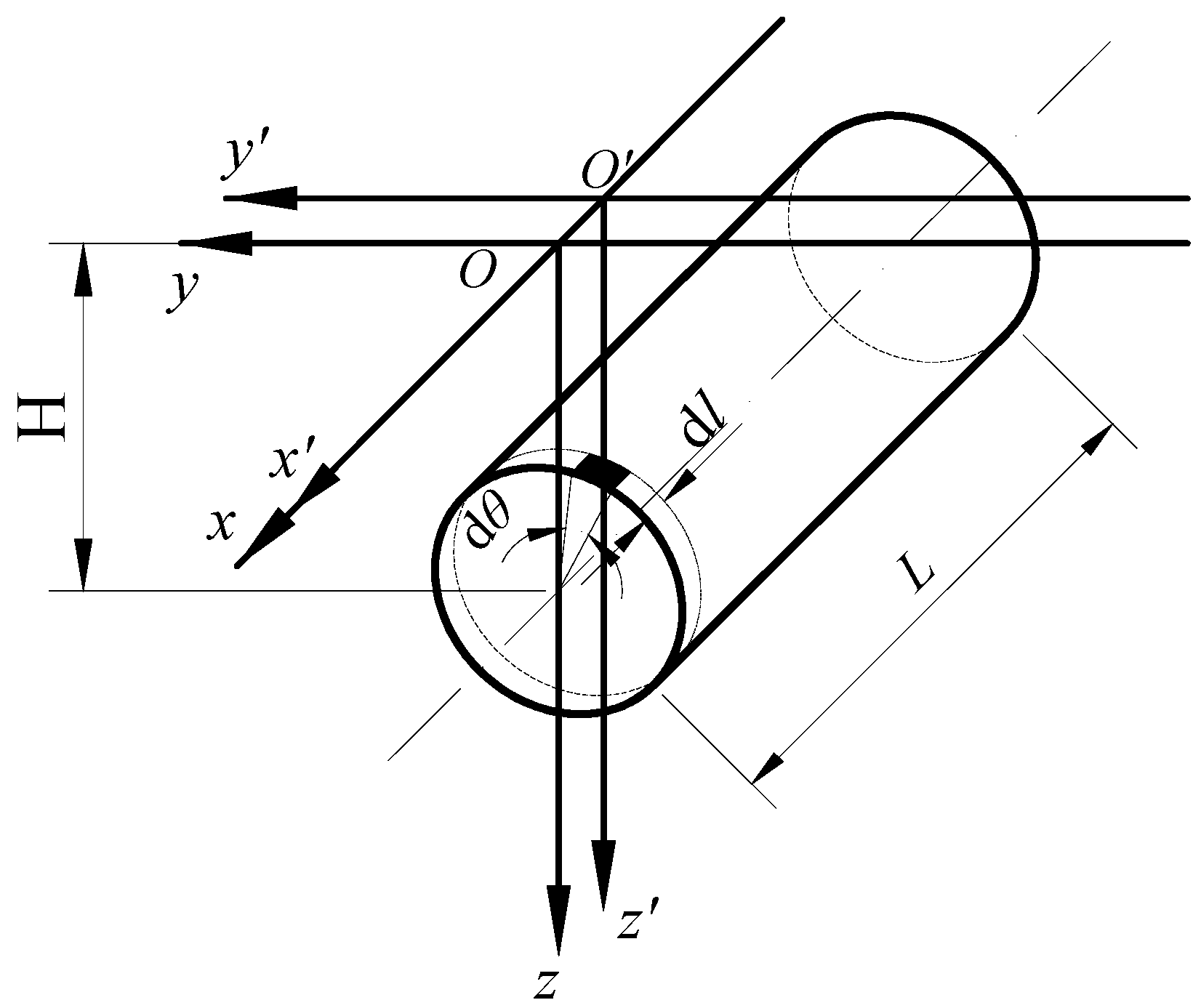
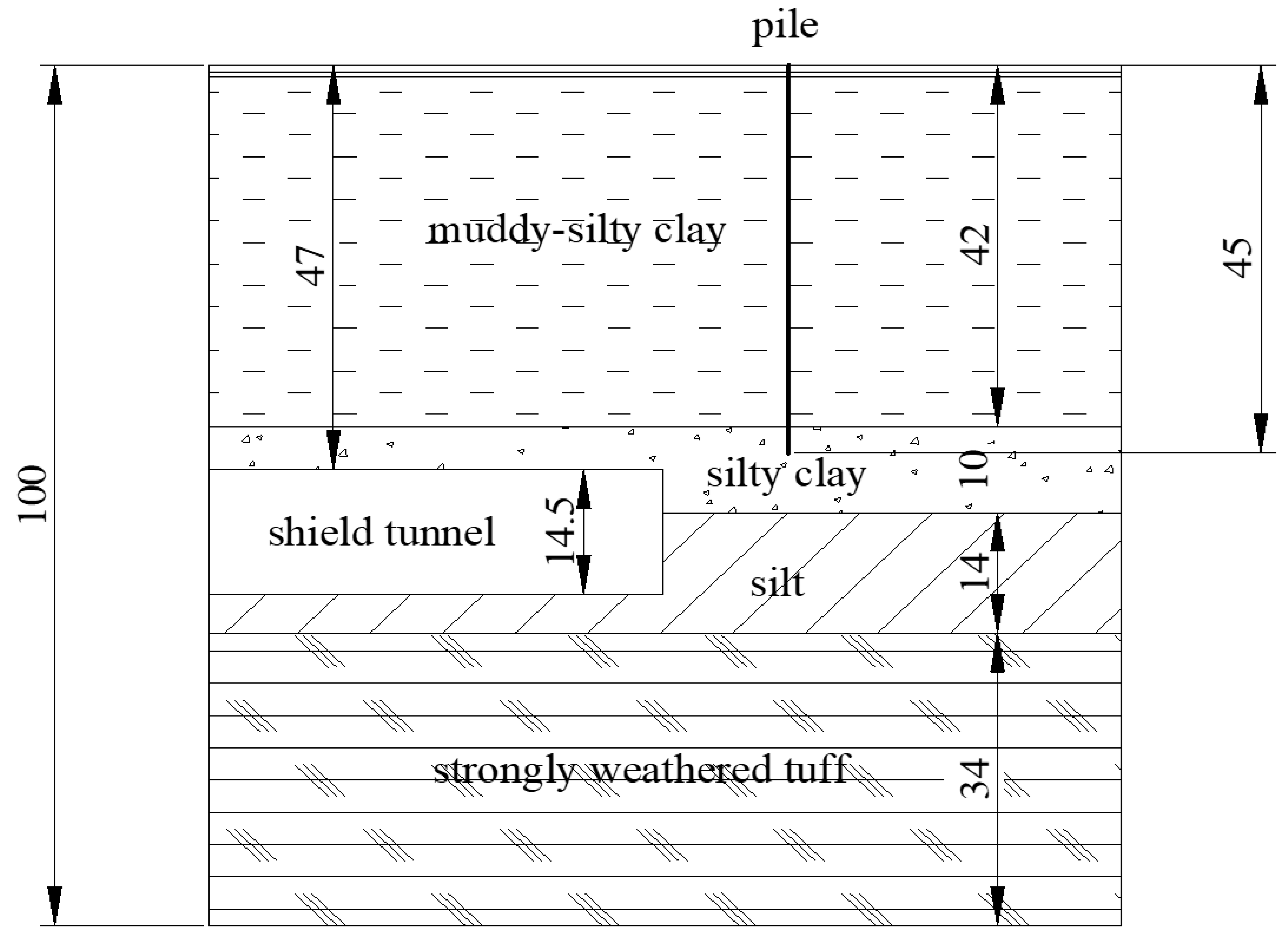
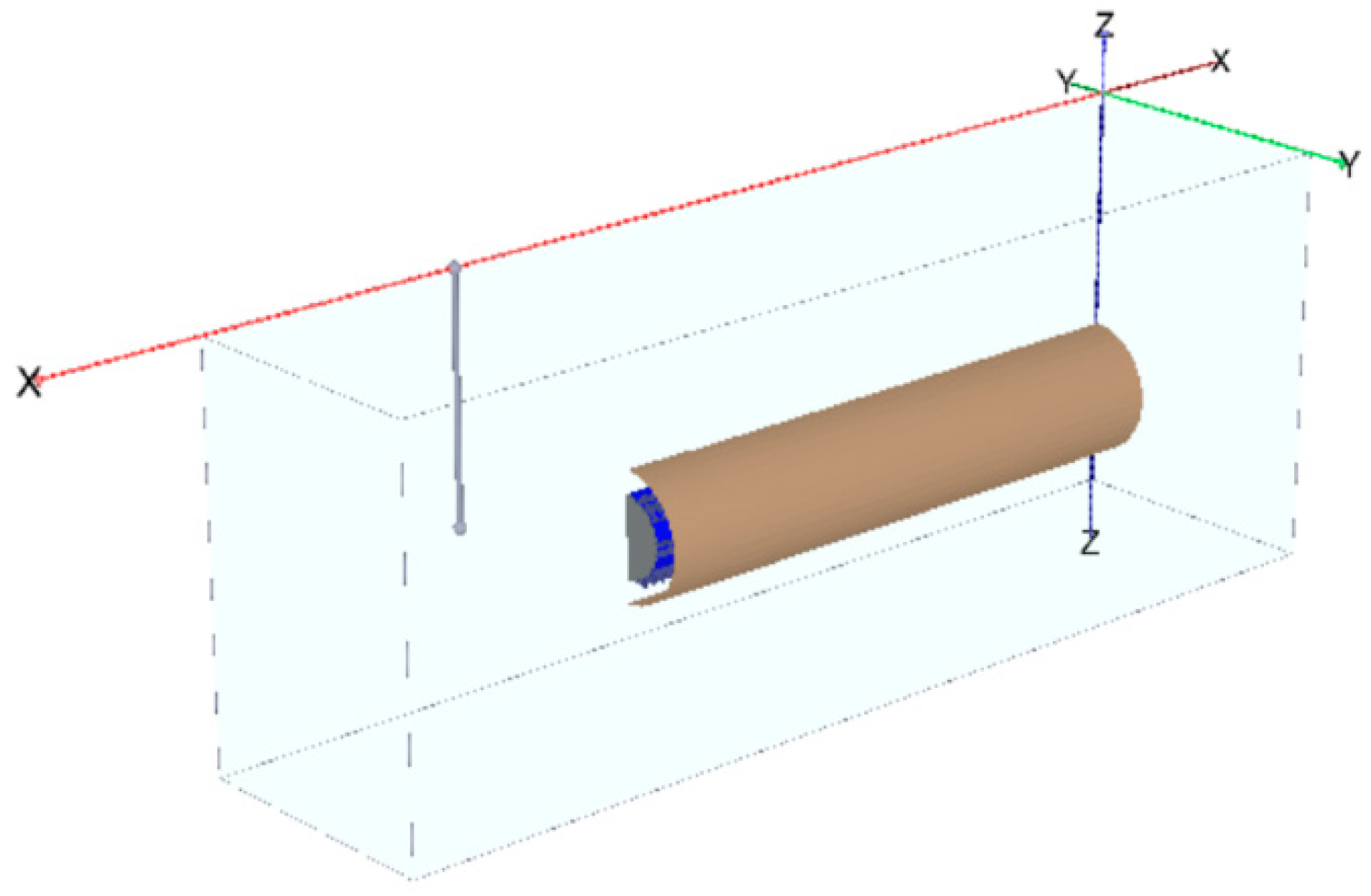
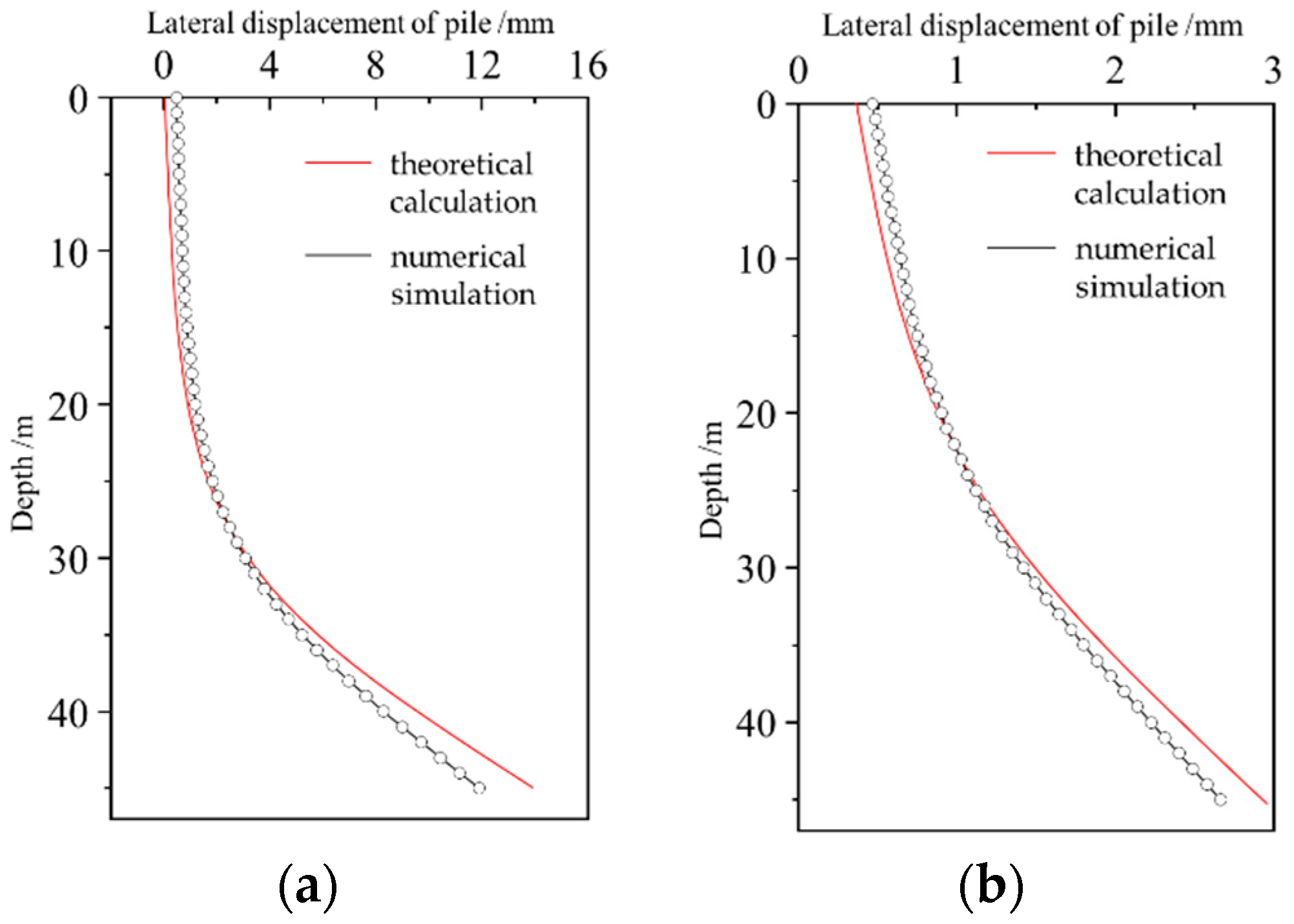
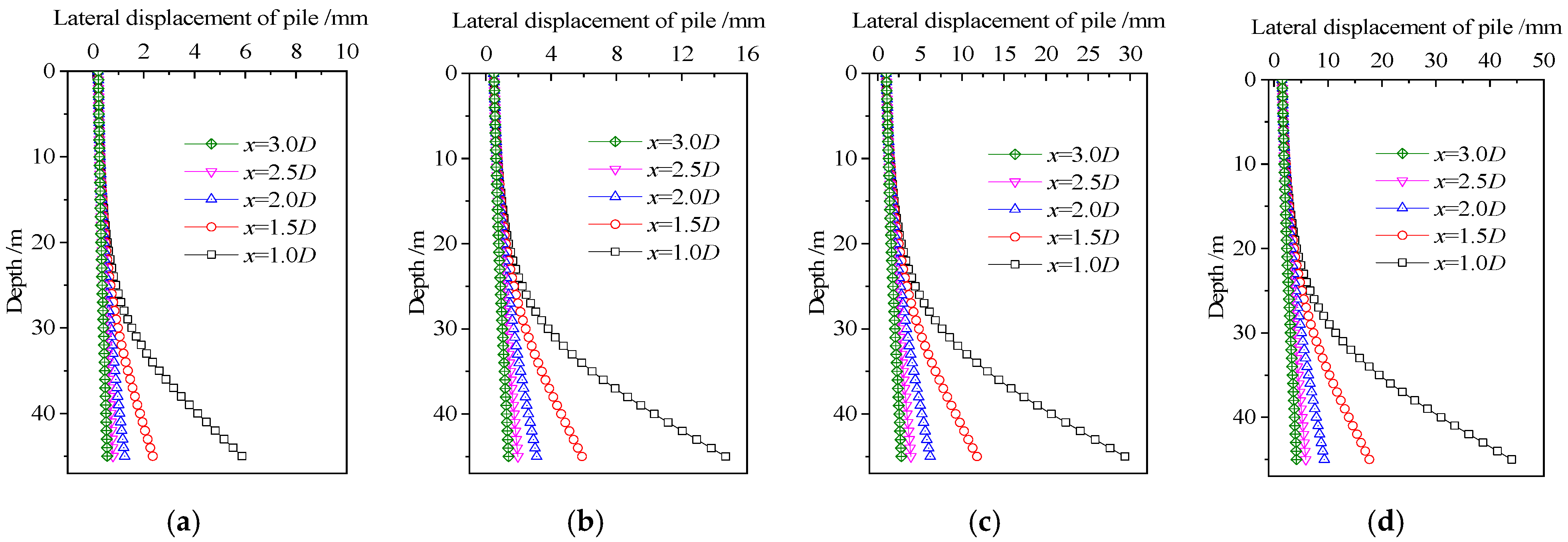
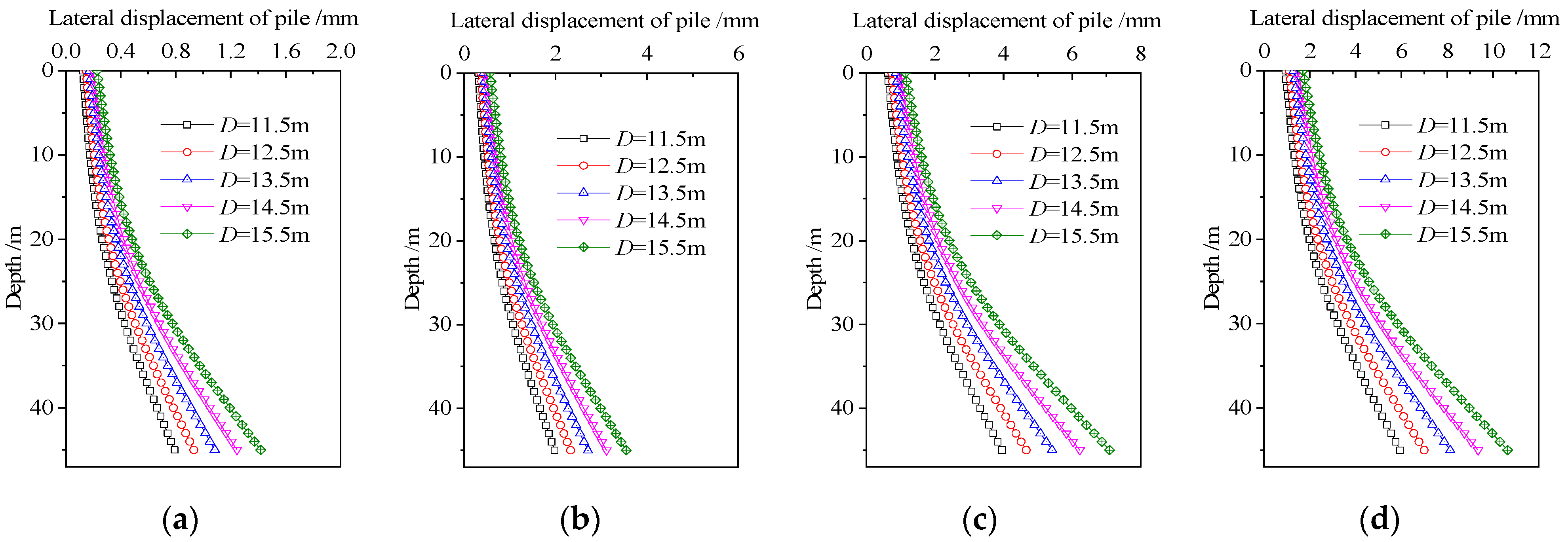
| Soil Layer | Unit Weight γ/kN·m−3 | Elastic Modulus Es/MPa | Poisson Ratio ν | Cohesion Force C/kPa | Internal Frictional Angle ψ/° |
|---|---|---|---|---|---|
| silty clay | 19 | 3.8 | 0.35 | 17 | 10.3 |
| Structure | Material | Equivalent Thickness D/m | Unit Weight γ/kN·m−3 | Equivalent Elastic Modulus E/kPa | Poisson Ratio ν |
|---|---|---|---|---|---|
| shield shell | C60 | 0.6 | 12 | 3.60 × 107 | 0.2 |
| Design Conditions | Values |
|---|---|
| Shield length L/m | 12 |
| Shield radius R/m | 7.25 |
| Additive thrust p/kPa | 20 |
| Friction resistance ratio β | 0.9 |
| Interface friction angle δ’/° | 8.0 |
| Coefficient of earth pressure at rest K0 | 0.5 |
| Foundation parameters of Kerr model m | 4 |
Disclaimer/Publisher’s Note: The statements, opinions and data contained in all publications are solely those of the individual author(s) and contributor(s) and not of MDPI and/or the editor(s). MDPI and/or the editor(s) disclaim responsibility for any injury to people or property resulting from any ideas, methods, instructions or products referred to in the content. |
© 2023 by the authors. Licensee MDPI, Basel, Switzerland. This article is an open access article distributed under the terms and conditions of the Creative Commons Attribution (CC BY) license (https://creativecommons.org/licenses/by/4.0/).
Share and Cite
Sun, Y.; Wang, F.; Meng, Z.; Wang, C. Analysis of Lateral Displacement of Pile Foundation Caused by Large-Diameter Shield Tunneling. Appl. Sci. 2024, 14, 272. https://doi.org/10.3390/app14010272
Sun Y, Wang F, Meng Z, Wang C. Analysis of Lateral Displacement of Pile Foundation Caused by Large-Diameter Shield Tunneling. Applied Sciences. 2024; 14(1):272. https://doi.org/10.3390/app14010272
Chicago/Turabian StyleSun, Yang, Faxin Wang, Zoulei Meng, and Chongxiao Wang. 2024. "Analysis of Lateral Displacement of Pile Foundation Caused by Large-Diameter Shield Tunneling" Applied Sciences 14, no. 1: 272. https://doi.org/10.3390/app14010272




